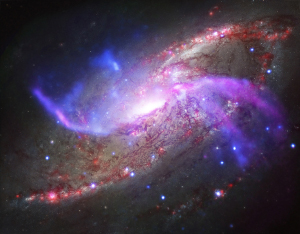A source for the most powerful cosmic rays?
Astronomers think they have discovered a region in the sky, within or near the Milky Way, which might be the source of the most energetic cosmic rays
Nobody knows how ultra–high-energy cosmic rays—mainly protons or heavier atomic nuclei—acquire energies millions of times higher than have been achieved with humanmade particle accelerators. (Physicists dubbed one of the first ones observed the “Oh-My-God particle.”) Lower energy cosmic rays are thought to spring from the lingering remnants of stellar explosions called supernovas. But such clouds are far too small to produce the highest energy cosmic rays. Instead, theorists generally expect that the most energetic cosmic rays rev up over millions of years in unidentified accelerators the size of galaxies.
The Telescope Array aims to help solve that mystery. When a high-energy cosmic array strikes the atmosphere, it disappears in an avalanche of lower energy particles. Those particles trigger the detectors in the array, enabling researchers to deduce the direction and energy of the original cosmic ray. From 2008 to 2013, researchers spotted 72 cosmic rays with energies above 57 exaelectron volts—15 million times the highest energy achieved with a particle accelerator. And 19 of them appear to cluster in a hotspot in the sky about 20° in radius, as Hiroyuki Sagawa, a co-representative for the Telescope Array team from the University of Tokyo, reported today in a press conference at the university. [emphasis mine]
The low number of detections, 19 out of 72 total, that seem to come from this wide 20 degree region, suggests that this report falls most certainly under the heading of “the uncertainty of science.” I would not be surprised at all if this conclusion does not stand up after further research.
Nonetheless, the article is worth reading because it outlines nicely this astronomical mystery. Something out there accelerates these particles to these high energies, and astronomers do not yet know what that something is.
Astronomers think they have discovered a region in the sky, within or near the Milky Way, which might be the source of the most energetic cosmic rays
Nobody knows how ultra–high-energy cosmic rays—mainly protons or heavier atomic nuclei—acquire energies millions of times higher than have been achieved with humanmade particle accelerators. (Physicists dubbed one of the first ones observed the “Oh-My-God particle.”) Lower energy cosmic rays are thought to spring from the lingering remnants of stellar explosions called supernovas. But such clouds are far too small to produce the highest energy cosmic rays. Instead, theorists generally expect that the most energetic cosmic rays rev up over millions of years in unidentified accelerators the size of galaxies.
The Telescope Array aims to help solve that mystery. When a high-energy cosmic array strikes the atmosphere, it disappears in an avalanche of lower energy particles. Those particles trigger the detectors in the array, enabling researchers to deduce the direction and energy of the original cosmic ray. From 2008 to 2013, researchers spotted 72 cosmic rays with energies above 57 exaelectron volts—15 million times the highest energy achieved with a particle accelerator. And 19 of them appear to cluster in a hotspot in the sky about 20° in radius, as Hiroyuki Sagawa, a co-representative for the Telescope Array team from the University of Tokyo, reported today in a press conference at the university. [emphasis mine]
The low number of detections, 19 out of 72 total, that seem to come from this wide 20 degree region, suggests that this report falls most certainly under the heading of “the uncertainty of science.” I would not be surprised at all if this conclusion does not stand up after further research.
Nonetheless, the article is worth reading because it outlines nicely this astronomical mystery. Something out there accelerates these particles to these high energies, and astronomers do not yet know what that something is.


